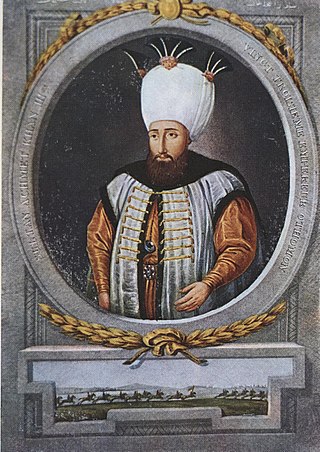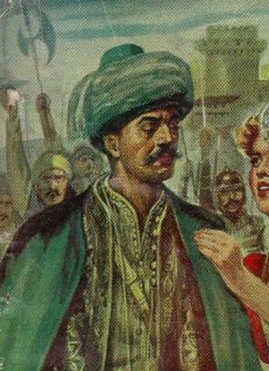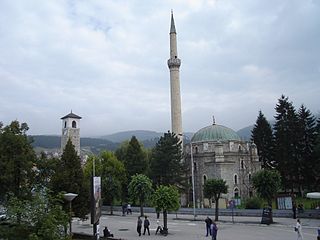
Ahmed III was Sultan of the Ottoman Empire and a son of Sultan Mehmed IV. His mother was Gülnuş Sultan, originally named Evmania Voria, who was an ethnic Greek. He was born at Hacıoğlu Pazarcık, in Dobruja. He succeeded to the throne in 1703 on the abdication of his brother Mustafa II (1695–1703). Nevşehirli Damat İbrahim Pasha and the Sultan's daughter, Fatma Sultan directed the government from 1718 to 1730, a period referred to as the Tulip Era.

The Province of Temeşvar, known as Province of Yanova after 1658, was a first-level administrative unit (eyalet) of the Ottoman Empire located in the Banat region of Central Europe.

The Eyalet of Sidon was an eyalet of the Ottoman Empire. In the 19th century, the eyalet extended from the border with Egypt to the Bay of Kisrawan, including parts of modern Israel and Lebanon.
Köprülü Abdullah Pasha was an Ottoman general of the first half of the 18th century and one of the commanders during the Ottoman-Hotaki War of 1722–27 as well as the Ottoman-Persian War of 1730–35.
Semiz Ali Pasha was an Ottoman statesman from the Sanjak of Bosnia who served as Grand Vizier of the Ottoman Empire from 1561 to 1565. He was the beylerbey (governor) of Egypt Eyalet from 1549 to 1553. Semiz Ali Pasha was born in Prača in Bosnia, and replaced Rüstem Pasha as a Grand Vizier. After palace schooling, he discharged high-level functions along the Ottoman Empire. His epithet "Semiz" means "fat" in Turkish.

Gazi Hüseyin Pasha, also known as Deli Hüseyin Pasha or Sarı Hüseyin Pasha or Baltaoğlu Hüseyin Pasha, was an Ottoman military officer and statesman. He was governor of Egypt (1635–1637), Kapudan Pasha in the 1630s, and briefly Grand Vizier in 1656.
Ivaz Mehmed Pasha, also known as Hacı Ivaz Mehmed Pasha or Hacı Ivazzade Mehmed Pasha, was an 18th-century Ottoman grand vizier and provincial governor.

Hekimoğlu Ali Pasha was an Ottoman statesman and military leader who served as Grand Vizier of the Ottoman Empire three times.
Nişancı Ahmed Pasha, also called Şehla Ahmed Pasha or Hacı Şehla Ahmed Pasha or Kör Vezir Ahmed Pasha, was an Ottoman Grand Vizier during the reign of Mahmud I. He was also the Ottoman governor of Egypt from 1748 to 1751.

Bodur Hüseyin Pasha was an Ottoman statesman and government official who served many high-level positions in the Ottoman Empire, including governorship of Bosnia (1594–95), of Damascus (1582–83), of Diyarbekir, of Budin, of Aleppo, of Van, of Anatolia, and of Egypt (1573–74).

Seyyid Emir Mehmed Pasha, known by the epithet "al-Sharif" among his Arab subjects, was an Ottoman statesman who served as defterdar, Ottoman governor of Egypt (1596–1598), and Ottoman governor of Damascus (1599–1600).
Haseki Mehmed Pasha was an Ottoman statesman and administrator. He served as the Ottoman governor of Damascus Eyalet, Egypt Eyalet (1652–56), Baghdad Eyalet (1656–59), and Aleppo Eyalet (1659–61). He married Gevherhan Sultan, daughter of Murad IV.
Osman-pasha the Bosnian or the Herzegovinian, known as Osman-paša Kazanac, was an Ottoman statesman who served as the governor of the Damascus Eyalet, of Anatolia Eyalet (1678–1680), of Egypt Eyalet (1680–1683), of Diyarbekir Eyalet (1683), of Bosnia Eyalet (1684), and of Eğri Eyalet (1685). His byname suggests that he hailed from the Sanjak of Bosnia or the Sanjak of Herzegovina.
Hasan Pasha was an Ottoman statesman who served as the Ottoman governor of Egypt Eyalet (1687), Baghdad Eyalet, and Shahrizor Eyalet (1591/92–1595/96). He also served as the warden of the Ottoman Sanjak of Rhodes and was a vizier.
Köse Halil Pasha, also known as Khalil Pasha al-Kawsaj, was an Ottoman statesman who served several high-level roles in the Ottoman Empire's administration, including serving as Defterdar and the Ottoman governor of Bosnia Eyalet (1699–1702), Erzurum Eyalet (1703–04), Van Eyalet (1704–06), Basra Eyalet, Sidon Eyalet (1708–1710), and Egypt Eyalet (1710–11). During his tenure in Erzurum, Hahil Pasha was in command of a military expedition in Georgia in 1703.
Veli Mehmed Pasha, also known as Mehmed Veli Pasha or Wālī Pasha, was an Ottoman statesman who served as Kapudan Pasha (1706–1707) and the Ottoman governor of Bosnia Eyalet (1707) and Egypt Eyalet.
Recep Pasha was an Ottoman statesman.
Moralı Ali Pasha was an Ottoman statesman. He was from the Peloponnese, which was historically called Morea.
Moralı Ibrahim Pasha, also known as Aşçı Ibrahim Pasha or Hacı Ibrahim Pasha or Ibrahim Pasha al-Kapudan, was an Ottoman statesman and grand admiral.
Sofu Mehmed Pasha was an Ottoman administrator. Born and raised in Razgrad, Mehmed Pasha served as the Ottoman governor of Egypt Eyalet, Rumelia Eyalet (1617), Sivas Eyalet (1617–19), and Budin Eyalet (1624–26).







